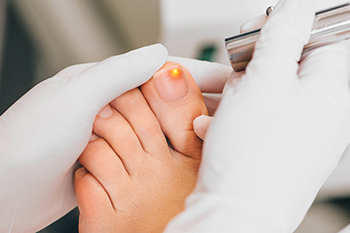Items filtered by date: April 2023
Plantar Hyperhidrosis Can Be Uncomfortable

Some people suffer from a condition that is known as hyperhidrosis. It is an uncomfortable ailment that can affect the feet and causes intense sweating. Patients may notice their shoes and socks become wet and are hesitant to wear sandals in warm weather. Their feet may also feel cold from the constant moisture, which may cause embarrassment. It is considered to be a medical condition that affects the sweat glands in the feet, and there may be methods that can be implemented for relief. Wearing shoe inserts may help to absorb some of the moisture, and can help the feet to refrain from slipping. Additionally, applying powder in the shoes and socks may also reduce moisture, and putting an antiperspirant in shoes may achieve similar results. Botox injections may be an option for some patients. If you have plantar hyperhidrosis, it is suggested that you are under the care of a podiatrist who can choose the best treatment method for you.
If you are suffering from hyperhidrosis contact Philip C. Caswell, DPM of Family Foot & Ankle Care. Our doctor can provide the care you need to attend to all of your foot and ankle needs.
Hyperhidrosis of the Feet
Hyperhidrosis is a rare disorder that can cause people to have excessive sweating of their feet. This can usually occur all on its own without rigorous activity involved. People who suffer from hyperhidrosis may also experience sweaty palms.
Although it is said that sweating is a healthy process meant to cool down the body temperature and to maintain a proper internal temperature, hyperhidrosis may prove to be a huge hindrance on a person’s everyday life.
Plantar hyperhidrosis is considered to be the main form of hyperhidrosis. Secondary hyperhidrosis can refer to sweating that occurs in areas other than the feet or hands and armpits. Often this may be a sign of it being related to another medical condition such as menopause, hyperthyroidism and even Parkinson’s disease.
In order to alleviate this condition, it is important to see your doctor so that they may prescribe the necessary medications so that you can begin to live a normal life again. If this is left untreated, it is said that it will persist throughout an individual’s life.
A last resort approach would be surgery, but it is best to speak with your doctor to find out what may be the best treatment for you.
If you have any questions, please feel free to contact our office located in Sparta, NJ . We offer the newest diagnostic and treatment technologies for all your foot care needs.
Foot Pain and Lifting Weights

Foot pain is a phenomenon that affects a wide range of individuals worldwide and can have various causes. People may experience foot pain after performing activities such as lifting weights. Specifically, when an individual lifts weights or performs deadlifts and lunges, they put extra pressure on their feet. If a person does not take enough time between lifting weights to rest, they may neglect recovery time, and foot pain may be more likely to occur. If someone is lifting weights with improper form and technique, this may also be a reason to develop unwanted foot conditions. If you frequently engage in weight lifting, it is suggested that you reach out to a podiatrist today who can provide you with appropriate treatment, if necessary.
Foot Pain
Foot pain can be extremely painful and debilitating. If you have a foot pain, consult with Philip C. Caswell, DPM from Family Foot & Ankle Care. Our doctor will assess your condition and provide you with quality foot and ankle treatment.
Causes
Foot pain is a very broad condition that could be caused by one or more ailments. The most common include:
- Bunions
- Hammertoes
- Plantar Fasciitis
- Bone Spurs
- Corns
- Tarsal Tunnel Syndrome
- Ingrown Toenails
- Arthritis (such as Gout, Rheumatoid, and Osteoarthritis)
- Flat Feet
- Injury (from stress fractures, broken toe, foot, ankle, Achilles tendon ruptures, and sprains)
- And more
Diagnosis
To figure out the cause of foot pain, podiatrists utilize several different methods. This can range from simple visual inspections and sensation tests to X-rays and MRI scans. Prior medical history, family medical history, and any recent physical traumatic events will all be taken into consideration for a proper diagnosis.
Treatment
Treatment depends upon the cause of the foot pain. Whether it is resting, staying off the foot, or having surgery; podiatrists have a number of treatment options available for foot pain.
If you have any questions, please feel free to contact our office located in Sparta, NJ . We offer the newest diagnostic and treatment technologies for all your foot care needs.
Plantar Warts Can Be Treated!
Successful Treatment Methods for a Broken Toe

A broken toe hurts. It can happen from stubbing it against a piece of furniture or dropping a heavy object. Immediate symptoms often include bruising and swelling, and walking is often difficult. A broken toe generally takes approximately four weeks to heal, and it can help to refrain from walking on it and frequently elevating the foot. Many people use crutches when they have a broken toe, which can help to provide mobility. A mildly broken toe can be treated by using the buddy taping method. This is done by taping the affected toe to the toe next to it, which generally provides the necessary stability as the healing process occurs. It is beneficial to place a piece of felt or foam between the toes, which helps to prevent the toes from rubbing against each other. If the bone is protruding from the skin, this is considered to be severely fractured and often requires medical attention from a podiatrist. If you have broken your toe, it is strongly suggested that you contact this type of foot doctor who can diagnose and treat this injury accordingly.
A broken toe can be very painful and lead to complications if not properly fixed. If you have any concerns about your feet, contact Philip C. Caswell, DPM from Family Foot & Ankle Care. Our doctor will treat your foot and ankle needs.
What to Know About a Broken Toe
Although most people try to avoid foot trauma such as banging, stubbing, or dropping heavy objects on their feet, the unfortunate fact is that it is a common occurrence. Given the fact that toes are positioned in front of the feet, they typically sustain the brunt of such trauma. When trauma occurs to a toe, the result can be a painful break (fracture).
Symptoms of a Broken Toe
- Throbbing pain
- Swelling
- Bruising on the skin and toenail
- The inability to move the toe
- Toe appears crooked or disfigured
- Tingling or numbness in the toe
Generally, it is best to stay off of the injured toe with the affected foot elevated.
Severe toe fractures may be treated with a splint, cast, and in some cases, minor surgery. Due to its position and the pressure it endures with daily activity, future complications can occur if the big toe is not properly treated.
If you have any questions, please feel free to contact our office located in Sparta, NJ . We offer the newest diagnostic and treatment technologies for all your foot care needs.
Laser Treatment for Nail Fungus

Toenail fungus, or onychomycosis, causes the nails to thicken, separate, and discolor. It is an affliction that is difficult to remove and stop from recurring. It is also contagious and can spread to other body parts and people directly exposed to it. Laser treatment uses concentrated light to help kill fungus and prevent its growth. This treatment started in the 1980s, and newer types of laser treatment have been introduced since then. Those who may benefit most from laser treatment for nail fungus include children, pregnant women, and those with underlying health conditions or problems with medication intolerances. The cost and number of sessions vary, as does insurance coverage. If you have a stubborn case of toenail fungus, it is suggested that you contact a podiatrist to discuss laser treatment as an option.
Laser treatment can be an effective way to get rid of toenail fungus. If you have any questions about laser treatment, consult with Philip C. Caswell, DPM from Family Foot & Ankle Care. Our doctor will assess your condition and provide you with quality treatment for fungal nails.
What Are Toenail Fungal Infections?
Onychomycosis, or fungal infection of the nail, is a relatively common and non-serious condition. Around 10 percent of U.S. citizens are afflicted with fungal nails. Common forms of fungus that infect the nail include dermatophytes, yeasts, and molds.
Symptoms of Toenail Fungal Infections Include:
- Nail thickening
- Brittleness of the nail
- Discoloration of the nail
Diagnosis for Fungal Nails
Fungal infections are diagnosed by fungal culture and microscopy. This will rule out any other conditions such as nail trauma, psoriasis, lichen planus, and onychogryphosis.
What Is Laser Treatment?
Laser treatment is a non-invasive, safe, quick, and painless procedure that uses the heat from a laser to kill fungus in the nail. Each infected nail is targeted with a laser for several minutes. The treatment is usually utilized several different times over a select period. During this time, a podiatrist will keep an eye on the infection.
If you have any questions, please feel free to contact our office located in Sparta, NJ . We offer the newest diagnostic and treatment technologies for all your foot care needs.

